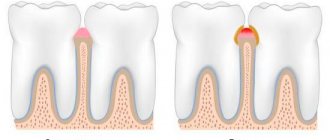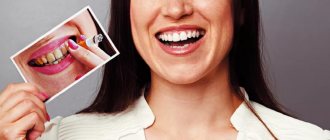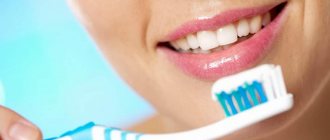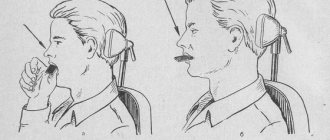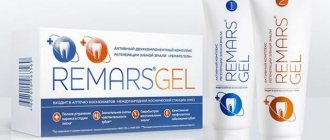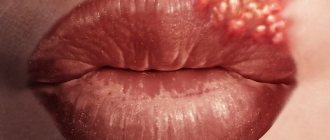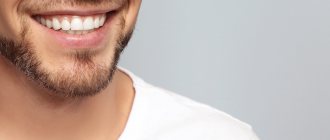Professional care
At an appointment with a specialist, teeth are cleaned with ultrasound.
A special device will remove plaque from the enamel and formed stones at the base of the teeth and under the gums. This procedure is virtually painless. You can't do this yourself. Stones and plaque appear after drinking tea, coffee, and cigarettes. The doctor will check the oral cavity for diseases (periodontal disease) and damage to the enamel (caries). If necessary, he will select the correct treatment and recommend proper dental care.
To strengthen tooth enamel, a specialist can perform fluoridation. It can be ordinary and deep, when special preparations are placed at the base of the tooth, which quickly restores the enamel.
Teeth whitening is carried out using the Air Flow system. It allows you to restore the natural color of your teeth and destroys bacteria. A special sandblasting machine is used, inside of which there is a special solution and an abrasive mixture. With its help, plaque is removed and tooth enamel is polished.
Personal hygiene
Represents daily oral care using special products:
- special brush;
- toothpaste or powder;
- floss;
- conditioner balms.
The main method of hygiene is the daily removal of food debris that harms the enamel and tooth tissue. The mucous membrane is well supplied with blood and serves as a site of colonization and infection by bacteria. If you do not pay enough attention to hygiene, active reproduction of pathogenic flora will begin.
If the patient is conscious
The algorithm for caring for the oral cavity of a seriously ill patient who is in clear consciousness is simpler. Patients in this category respond adequately to the nurse’s instructions and perform all the actions that are required of them to implement high-quality oral hygiene.
Preparation
Before you begin the daily procedure for caring for the patient’s oral cavity, the following preparation rules must be observed:
- Take care in advance of the sterility of hygiene products that will be used in the process of cleaning the teeth, the inside of the cheeks and the surface of the patient’s tongue.
- In 5 min. Before you start cleaning your mouth, pour boiling water over the patient’s toothbrush so that the pathogenic microflora dies and it becomes softer.
- Pour about 150 ml of dental balm intended for rinsing the mouth into a clean, washed glass.
- Take dental floss with you, which will allow you to carry out effective hygiene in the interdental space where the brush bristles cannot reach.
- Make sure you have a small pillow and a clean towel that are placed under the head of a seriously ill patient, as well as on the surface of his chest. These things are necessary for caring for the oral cavity without the risk of liquid or toothpaste getting into the patient's larynx.
- Prepare a set of sterile medical gloves, which are put on immediately before starting the hygienic procedure.
- Carry with you a package of dental wipes necessary to remove food particles or bacterial plaque from the inside of the patient’s cheeks and tongue.
- Before you begin the hygiene procedure, you should thoroughly wash your hands using soap, warm water and a clean, dry towel. Similar actions are performed immediately upon completion of the hygiene procedure.
Caring for the oral cavity of a seriously ill patient, the implementation algorithm of which includes the hygiene of the entire surface of his mucous membrane, should be carried out at the same time of day.
The best option is to brush your teeth immediately after finishing breakfast or dinner. This approach will prevent the development of bacterial infections inside the oral cavity, as well as the occurrence of inflammatory diseases in the form of stomatitis, glossitis, periodontitis, and gingivitis.
Procedure step by step
Proper care of the oral cavity of a patient in serious condition ensures the preservation of the health of the teeth, epithelial tissue and mucous membrane of this part of the body. The table below presents a set of actions that a person must perform when performing oral hygiene for a bedridden patient with signs of a serious illness.
| Action name | The procedure for performing the hygiene procedure |
| Transfer the patient to a half-sitting position | In order to carry out high-quality cleaning of the patient’s oral cavity, it is necessary to fix his head in the most vertical position. Using your working hand, you should elevate the patient's neck and shoulder girdle, and then place a high pillow under him. After performing these steps, the patient will be in an almost sitting position. During hygienic manipulations inside his mouth, water and foam from toothpaste will not flow into the larynx. This will minimize the risk of liquid entering the respiratory system. Especially when a seriously ill patient has suffered a cerebral stroke and his swallowing function is impaired. |
| Preventing fluid from entering the neck and chest | After the patient is transferred to a half-sitting position, a thick cloth towel should be placed on the surface of his neck and upper chest. If fluid leaks from the oral cavity, the patient's body will remain completely dry. In this case, it will be possible to increase the patient’s comfort and prevent the occurrence of unpleasant sensations. Instead of a towel, you can also use a diaper or special oilcloth material designed to carry out this kind of manipulation. |
| Antiseptic treatment of the mucous membrane of the inner surface of the cheeks | The beginning of hygienic care for the oral cavity of a seriously ill patient should begin with a general examination. After this, the nurse cleans the mucous membrane of the inner surface of the cheeks from food debris and plaque, which are waste products of bacterial microorganisms. To perform antiseptic treatment, it is recommended to use dental wipes, which are completely safe and also contain antiseptic substances. First, the entire inner surface of the mucous membrane of one cheek is treated, and then similar actions are performed on the other side of the oral cavity. |
| Teeth cleaning | After the mucous membrane of the cheeks is cleansed, the stage of dental enamel hygiene begins. To do this, you need to take a soft-bristled brush, apply a sufficient amount of toothpaste to its surface, and then begin the stroke procedure. Removing plaque begins with brushing the very last teeth. Then you need to smoothly move towards the front row of molars. Using a toothbrush, you should make circular movements, covering the entire area of the teeth. The average duration of molar cleaning is 2-3 minutes. depending on their quantity and the degree of contamination with bacterial plaque. During this procedure, special attention should be paid to the general condition of the teeth and the possible onset of caries. To clean the interdental space, you must use dental floss. |
| Antibacterial care for the surface of the tongue | Immediately after completing the teeth cleaning stage, it is necessary to perform an antibacterial treatment of the surface of the tongue. To do this, this part of the oral cavity can be cleaned with a brush bristle, making several circular movements, or you can use dental wipes. This procedure is mandatory if, during a preliminary examination of the patient’s oral cavity, a bright yellow, brown or green bacterial coating was found on the surface of the tongue. The average duration of antiseptic treatment of this area of the oral cavity is no more than 40 seconds. |
| Removing mucus from the back of the throat and tonsils | Removal of mucous contents from the back wall of the throat and tonsils is carried out if the patient suffers from infectious and inflammatory processes that are localized inside the oral cavity. This stage of hygienic care is not necessary for patients who have a healthy throat and tonsils. It is enough to perform the usual rinsing of the larynx with an antiseptic solution for dental care. |
| Rinsing the mouth with an antiseptic solution | Upon completion of the process of cleaning the mucous membrane of the cheeks, the surface of the tongue and the enamel of the teeth, the final stage of hygiene of the patient’s oral cavity begins. In this case, 150 ml of solution or balm for oral care is poured into the patient. The patient rinses his teeth independently or with the help of a nurse. The patient spits the liquid into a pre-prepared bowl or any other container that is convenient to use for caring for a specific seriously ill person. If desired, you can gargle. |
| Returning the patient to the starting position | After oral hygiene is completely completed, the working hand is placed behind the patient’s neck and partly the shoulders, lifted, and then a pillow is taken out from behind the back. At this stage, the patient returns to the original supine position. |
Caring for the oral cavity of a seriously ill patient (the algorithm for performing these actions can be adjusted depending on the patient’s well-being) lasts on average at least 10 minutes.
High-quality implementation of 1 such hygiene procedure allows you to prevent the development of pathogenic microflora and preserve the freshness of the patient’s breath. The next cleaning of the oral cavity can be carried out after 8-12 hours, if there are no direct medical indications for more frequent performance of this type of action.
General hygiene rules
There are simple rules for caring for your teeth and oral cavity. They must be taught from early childhood. The best thing is the example of adults. Forming such a habit is a very important step in creating a “Hollywood smile” in the future. To do this you need:
- Brush your teeth thoroughly every morning. The second time must be before bedtime;
- after snacks, clean with a special thread (floss);
- use fluoride-containing pastes;
- visit the dentist 2 times a year.
Proper nutrition is also important to keep your mouth healthy. A lack of fluoride can lead to premature destruction of tooth enamel. Products containing many chemical fillers (chips, crackers, carbonated sweet water) negatively affect the appearance of teeth and lead to darkening.
Professional cleaning
Since it is impossible to provide proper protection of the oral cavity from caries and other more serious diseases at home, dentists insist on visiting professional cleaning at least twice a year. The main advantages of this procedure:
- reduction of pathogenic microflora;
- increasing local immunity;
- removal of dental plaque.
Professional cleaning includes several stages:
- Removing soft plaque using the Air Flow air-abrasive technique. The device precisely delivers a powerful water-air jet, saturated with small abrasive particles, onto the tooth surface. Thanks to this, the area of the periodontal canals is cleared of pigmented plaque.
- Ultrasonic cleaning. Has antibacterial and antimicrobial effects. Thanks to thin attachments, the ultrasonic method helps remove stone from the supragingival part of the tooth, from under the gum and from the gingival canals.
- Polishing enamel with special pastes. To prevent plaque from sticking to the teeth, their surface should be as smooth as possible. Phyto-extracts have a mild whitening effect and also help strengthen the enamel.
- Strengthening fluoride therapy. This stage is not mandatory, but is carried out at the request of the patient. Disposable mouth guards are filled with a special remineralizing gel and placed on the upper and lower jaw. The gel lasts until it forms a thin protective film and is then washed off with water.
“Even with high-quality personal hygiene (and not everyone can boast of it) and cleansing of soft plaque, hard plaque (tartar) forms. This is due to both food debris and the mineral composition of saliva. Dental plaque contains a huge number of bacteria that cause and maintain inflammation in the periodontal tissues (tissues surrounding the tooth). Constantly inflamed gums cause bad breath, bleeding, and the saddest consequence is the destruction (loss) of bone tissue around the tooth. This disease is called periodontitis or periodontal disease, and it is what leads to tooth loss. With age, the rate of formation of hard plaque increases, and the risk of remaining without teeth increases. Regular professional hygiene allows you to promptly remove hard plaque and, therefore, protects teeth from falling out.”
Sergey Andreev
Candidate of Medical Sciences, dentist-therapist, orthopedic dentist, pediatric dentist
Cleaning accessories
Everyone should have their own toothbrush. How to choose a toothbrush? What are they? When coming to a store, customers often choose products that they like better in appearance. There are many types of toothbrushes; everyone should choose one for themselves according to the recommendations.
Types of brushes
- Mechanical is the most popular and inexpensive.
- Electric is more expensive. Less effort is needed to cleanse.
In addition, you need to pay attention to the stubble. It comes in different hardnesses. You need to make the right choice:
- very soft, suitable for children and adults with sensitive enamel;
- soft – for adults with bleeding gums;
- medium – the most popular and is suitable for children over 12 years old and adults;
- hard is suitable for those who quickly develop plaque and wear braces.
A regular brush has been selected, but you still need to choose the right toothpaste. Depending on the condition of your oral cavity, your doctor can recommend the choice of toothpaste.
Types of pastes
- whitening;
- to strengthen gums;
- fluorine-containing;
- for sensitive teeth;
- children's.
Before purchasing paste, you need to know exactly what problem needs to be solved. Pay attention to the composition. The best pastes are made on a natural basis. Chemical additives in large quantities can be harmful.
Dental floss or floss is needed to properly care for your teeth. The human tooth has five surfaces; a brush cannot reach all sides. Especially a lot of food settles on the sides. Threads are used for removal. They come in different types and qualities:
- round or flat;
- waxed or not;
- different strength;
- impregnated with various compounds (chlorhexidine, menthol, antiseptics).
When buying such threads, pay attention to their quality.
Many dentists recommend a modern device for cleaning the oral cavity - an irrigator - for home use. Different types of devices are available. It is an addition to a toothbrush and is used after brushing your teeth for a more complete cleansing of the oral cavity.
Hygienic baths with antiseptic
Mouth rinsing is an integral part of postoperative care. However, after a sinus lift, active rinsing of the mouth should be replaced with baths. This is due to the fact that after the operation it is necessary to avoid pressure changes in the oral cavity. Baths should be carried out after each meal; for this purpose, it is better to purchase a medicine with pronounced antiseptic properties. Chlorhexidine, Miramistin, Tantum Verde and other antiseptics widely used in dentistry and otorhinolaryngology are good options.
The bath should be done before applying the adhesive paste or gel. To do this, after eating, you should take a small amount of antiseptic and distribute it in the oral cavity, mainly on the side of the operation. There is no need to rinse your mouth; you just need to hold the solution in your mouth for 2-3 minutes and then spit it out. This will be enough to get rid of pieces of food, relieve inflammation and have an antimicrobial effect on the oral mucosa. Baths should not be done too often; 3-4 times a day after main meals will be enough.
Step-by-step method of cleaning the oral cavity
How to brush your teeth properly should be taught from childhood. Then this habit will remain for life. We must remember that the tongue and cheeks should be cleaned. Germs also accumulate in these places. Many people brush their teeth incorrectly. How to do it correctly:
- wet the brush and apply the paste;
- We clean the upper ones from the gums to the edge of the tooth. There are 4-5 movements near each. We start from the rear and move to the front;
- We do the same with the inner edge;
- We brush wide teeth from above horizontally;
- We do the same with the bottom row;
- in conclusion we clean our tongue;
- We close the teeth and massage the gums in a circular motion, lightly pressing the brush.
Dentists recommend brushing from the gum to the edge to prevent food from getting stuck between the teeth.
Consequences of poor hygiene
Improper oral care can lead to irreversible consequences. If personal hygiene is lacking, this leads to the following consequences:
- bad breath;
- destruction of enamel, the appearance of caries;
- periodontal disease;
- inflammation and bleeding of gums;
- gumboil, loss of teeth;
- poor digestion due to lack of teeth;
- violation of smile aesthetics.
To avoid health problems and to have a dazzling smile, you should learn the rules of personal hygiene from childhood and do not forget to visit the dentist for preventive purposes.
Caring for the ears, eyes, nose and mouth
Contents Nose care
Ear care
Eye care
Oral care
What not to do
If you are caring for a weakened or immobile person, remember the rules of hygiene and special body care. Together with experts, we have prepared a guide on how to care for a person’s face and recommendations for procedures.
Things to remember:
- Eyes. It is important to prevent purulent diseases.
- Ears. It is important to prevent the appearance of wax plugs. They reduce hearing and create the sensation of tinnitus.
- Nose. It is important to clear your nose of mucus and crusts. They make breathing difficult and cause discomfort.
- Mouth. It is important to reduce the risks of developing stomatitis and ulcers. Proper care regulates salivation to moisturize the oral mucosa.
Important: Always warn the person about all your actions and manipulations. Even if he is sleeping or unconscious, and, as it seems to you, does not hear or understand you.
Nose care
Carry out the procedure daily and as needed.
You will need:
- Cotton swabs or turundas made from gauze napkins. Sterile turundas can be purchased at the pharmacy or made from clean cotton pads: take half a cotton pad and wrap it around the end of a toothpick, then remove the toothpick and further tighten the turunda by twisting it.
- Vaseline oil (or olive/baby moisturizing oil),
- Towel or diaper.
- Wash your hands and put on gloves.
- Put an apron on the patient.
- Soak a cotton swab (turunda) in a bottle of Vaseline oil. The stick (turunda) should be moistened evenly and moderately so that the oil does not drip from it.
- Take the stick or turunda in your right hand. With your left hand, lift the tip of the patient’s nose and gently, with rotational movements, insert the stick (turunda) into the nostril.
- If a sick person has dry crusts in the nose, hold the stick (turunda) for 1-2 minutes to soften them.
- Remove the cotton swab using a rotating motion.
- Take a clean stick (turunda), soak it in a bottle of Vaseline oil and repeat the procedure until the crusts are completely removed.
- Treat the other nasal passage in the same way.
Important Do not insert a turunda or a cotton swab deep into the nasal passage - this can cause pain and damage the nasal mucosa or thin septum.
Ear care
You will need:
- Boiled water at room temperature.
- Water container.
- Cotton pad (turundas or gauze pads).
- Towel or diaper.
- Absorbent diaper (if the person cannot sit).
Carry out the procedure 1-2 times a week, and also as the ears become dirty.
- Wash your hands.
- Place a towel or diaper on the patient's chest. If a person cannot sit, place an absorbent napkin (diaper) under his head.
- Soak a cotton pad (turunda or gauze) in water and squeeze.
- Using two fingers, gently pull back on the top of your ear to straighten your ear canal.
- Gently wipe the pinna and area behind the ears.
- Repeat the treatment 4-5 times, changing cotton pads (turundas, gauze napkins).
- Treat the other ear in the same way.
Important
- Do not clean the external auditory canal with sharp objects or cotton swabs - they can damage the eardrum or the wall of the ear canal, and also cause infection.
- If you think that a sick person has a wax plug, consult a doctor. Don't try to get rid of it yourself! Tinnitus can be a consequence of infection or taking medications.
Eye care
You will need:
- Boiled water (or chamomile decoction) at room temperature.
- Water container.
- Gauze balls (or cotton pads).
- Towel or diaper.
Carry out the procedure daily in the morning after the patient wakes up, since during sleep, secretions form in the eyes, which stick together the eyelashes. Dry crusts may appear on the eyelids that need to be removed.
- Wash your hands.
- Prepare a container with water or chamomile infusion.
- Place a towel on the patient's chest.
- Take a gauze ball or cotton pad and soak it in the solution and squeeze it out.
- Wipe eyelashes and eyelids from the outer corner to the inner.
- Repeat the treatment 4-5 times, changing balls (cotton pads).
- Blot the remaining solution on your eyes with a dry ball (cotton pad).
- Treat the other eye in the same way.
Sometimes the patient's blinking process slows down, so the mucous membrane of the eye may dry out. To avoid this, you can use moisturizing drops (“Artificial tears”)—1-2 drops in the corner of the eye every 2 hours. Consult your physician before use.
Important
- Do not wipe both eyes with the same gauze ball or cotton pad - you can spread the infection from one eye to the other.
- Do not use cotton wool as it will leave lint on your eyelashes.
- Do not wipe your eyes with a solution of hydrogen peroxide instead of water or chamomile infusion. If it comes into contact with the eyes, it may cause pain and irritation.
Oral care
Carry out the procedure daily in the morning and evening, as well as after each meal and after bouts of vomiting. Severely ill people are at increased risk of oral infections and require ongoing care.
You will need:
- Brush and spatula for the oral cavity (can be purchased at the pharmacy).
- Gauze napkins.
- Freshly squeezed lemon juice with glycerin (1:2).
- Capacity.
- Waterproof diaper or towel.
- Hygienic lipstick.
You can replace the spatula, gauze pads and lemon juice with glycerin with special oral care sticks - sold at the pharmacy.
Skin care products for a sick person: how to choose? We help you understand the variety of foams, dry shampoos, creams and lotions for hygiene, including in special cases - with bedsores, an established stoma, urinary and fecal incontinence Evgeniya RezvanCar Care Workshop
Care
Important It is not necessary to turn a bedridden patient from one side to the other while brushing your teeth - the entire oral cavity can be treated in a position on its side.
- Turn the patient on his side so that his face is on the edge of the pillow.
- Place an absorbent diaper under his head and on his chest.
- Place the container under your chin.
- Soak your toothbrush in lemon juice and glycerin.
- Ask to open your mouth slightly or carefully, without using force, do it yourself with the consent of the patient.
- Using a “sweeping” motion from top to bottom, move along the person’s lower and upper jaws. Repeat several times for 30-40 seconds.
- Wrap the spatula in gauze and soak it in lemon juice and glycerin.
- Gently treat the inner surface of the cheeks, tongue, sublingual area, and hard palate. If there is plaque on the tongue, it must be cleaned with a soft brush or spatula with a gauze cloth.
- Apply chapstick to the person's lips (optional).
- If the person is conscious, let him brush his teeth with a brush and toothpaste himself, and you help him if necessary! If it is difficult for the patient to get to the bathroom, organize everything for this in bed, using an apron, a towel and a spitting container. It is important that a person maintains independence as long as possible.
Important
- To prevent inflammation of the oral mucosa (stomatitis), antiseptic solutions and sprays can be used. If the patient can rinse on his own, then in the form of a liquid; if not, in the form of a spray.
- You can give a small piece of ice to dissolve 2-3 times a day. It will freshen your mouth.
What not to do
- Do not carry out care without consulting a doctor if you have oral cancer. Sometimes, after chemotherapy, oval-shaped ulcers (aphthae) appear in the mouth. In this case, treating the oral cavity with a solution of lemon juice and glycerin is dangerous and painful.
- Do not brush or toothpaste if the person is unable to get out of bed or sit up and has no way to rinse their mouth. In this case, use special sticks or a spatula with a gauze cloth.
- Do not use a hard or medium-hard brush - this can damage your gums.
Important If a person wears dentures, it is important to take them out and carefully carry out oral hygiene to remove food debris and rinse the dentures themselves. Make sure they don't rub. If necessary, consult a specialist.
To make sure you do everything correctly, watch the webinars Peculiarities of caring for the mouth and nose in a seriously ill person and Peculiarities of caring for the eyes and ears of a seriously ill person.
And here you can download the memo so that it is always at hand
Participated in the creation of the material: E.N. Semenova, State Budgetary Healthcare Institution "Center for Palliative Care of the Department of Healthcare", E.A. Druzhinina, branch of the Tsaritsyno Hospice, Arif Ibragimov, State Budgetary Institution "Center for Palliative Care of the Department of Healthcare", State Budgetary Institution "NIIOZMM DZM".
The material was prepared with the participation of the “Caring Workshop”, a project of the Vera Hospice Charitable Foundation, using a grant from the President of the Russian Federation for the development of civil society provided by the Presidential Grants Foundation.
